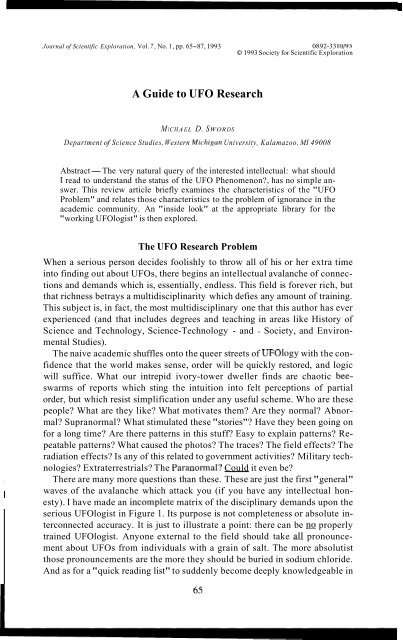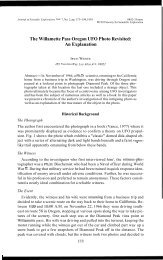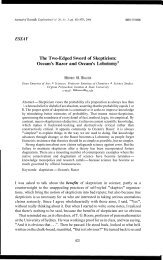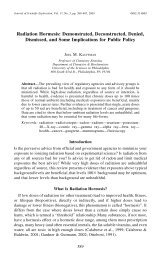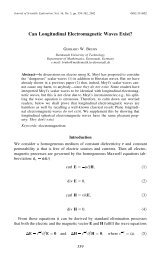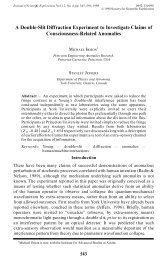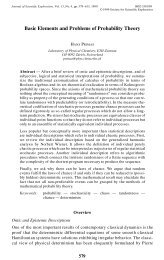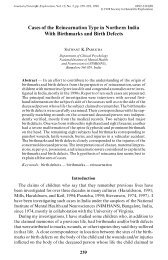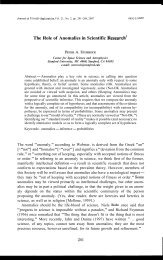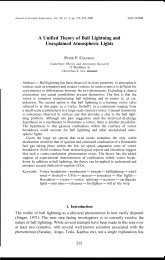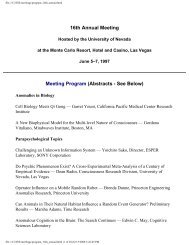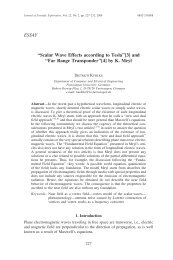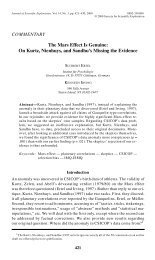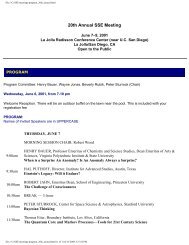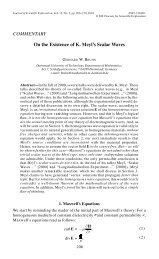A Guide to UFO Research - Society for Scientific Exploration
A Guide to UFO Research - Society for Scientific Exploration
A Guide to UFO Research - Society for Scientific Exploration
You also want an ePaper? Increase the reach of your titles
YUMPU automatically turns print PDFs into web optimized ePapers that Google loves.
Journal of <strong>Scientific</strong> <strong>Exploration</strong>, Vol. 7, No. 1, pp. 65-87, 1993 0892-33 10193<br />
O 1993 <strong>Society</strong> <strong>for</strong> <strong>Scientific</strong> <strong>Exploration</strong><br />
A <strong>Guide</strong> <strong>to</strong> <strong>UFO</strong> <strong>Research</strong><br />
MICHAEL D. SWORDS<br />
Department of Science Studies, Western Michigun University, Kalamazoo, MI 49008<br />
Abstract-The very natural query of the interested intellectual: what should<br />
1 read <strong>to</strong> understand the status of the <strong>UFO</strong> Phenomenon?, has no simple answer.<br />
This review article briefly examines the characteristics of the "<strong>UFO</strong><br />
Problem" and relates those characteristics <strong>to</strong> the problem of ignorance in the<br />
academic community. An "inside look" at the appropriate library <strong>for</strong> the<br />
"working <strong>UFO</strong>logist" is then explored.<br />
The <strong>UFO</strong> <strong>Research</strong> Problem<br />
When a serious person decides foolishly <strong>to</strong> throw all of his or her extra time<br />
in<strong>to</strong> finding out about <strong>UFO</strong>s, there begins an intellectual avalanche of connections<br />
and demands which is, essentially, endless. This field is <strong>for</strong>ever rich, but<br />
that richness betrays a multidisciplinarity which defies any amount of training.<br />
This subject is, in fact, the most multidisciplinary one that this author has ever<br />
experienced (and that includes degrees and teaching in areas like His<strong>to</strong>ry of<br />
Science and Technology, Science-Technology - and - <strong>Society</strong>, and Environmental<br />
Studies).<br />
The naive academic shuffles on<strong>to</strong> the queer streets of <strong>UFO</strong>logy with the confidence<br />
that the world makes sense, order will be quickly res<strong>to</strong>red, and logic<br />
will suffice. What our intrepid ivory-<strong>to</strong>wer dweller finds are chaotic beeswarms<br />
of reports which sting the intuition in<strong>to</strong> felt perceptions of partial<br />
order, but which resist simplification under any useful scheme. Who are these<br />
people? What are they like? What motivates them? Are they normal? Abnormal?<br />
Supranormal? What stimulated these "s<strong>to</strong>ries"? Have they been going on<br />
<strong>for</strong> a long time? Are there patterns in this stuff? Easy <strong>to</strong> explain patterns? Repeatable<br />
patterns? What caused the pho<strong>to</strong>s? The traces? The field effects? The<br />
radiation effects? Is any of this related <strong>to</strong> government activities? Military technologies?<br />
Extraterrestrials? The Paranormal? Could it even be?<br />
, There are many more questions than these. These are just the first "general"<br />
I<br />
waves of the avalanche which attack you (if you have any intellectual honesty).<br />
I have made an incomplete matrix of the disciplinary demands upon the<br />
serious <strong>UFO</strong>logist in Figure 1. Its purpose is not completeness or absolute interconnected<br />
accuracy. It is just <strong>to</strong> illustrate a point: there can be no properly<br />
trained <strong>UFO</strong>logist. Anyone external <strong>to</strong> the field should take pronouncement<br />
about <strong>UFO</strong>s from individuals with a grain of salt. The more absolutist<br />
those pronouncements are the more they should be buried in sodium chloride.<br />
And as <strong>for</strong> a "quick reading list" <strong>to</strong> suddenly become deeply knowledgeable in
M. D. Swords<br />
( His<strong>to</strong>ry 1<br />
Government<br />
& Military<br />
His<strong>to</strong>ry<br />
His<strong>to</strong>ry of<br />
Technology &<br />
Future Studies<br />
I of the <strong>UFO</strong> 1<br />
\ Phenomena<br />
Fig. 1<br />
the "problem": (as Alexander the Great may have been <strong>to</strong>ld) there is no royal<br />
road <strong>to</strong> <strong>UFO</strong>logy.<br />
A few further words about the multidisciplinary matrix be<strong>for</strong>e going on with<br />
another serious problem vis-a-vis "reading about <strong>UFO</strong>s". We highly trained intellects,<br />
all proud of our mental abilities and acquired knowledge, have tended<br />
not <strong>to</strong> behave very well in the face of this daunting array of demands. Some individuals,<br />
having barely paddled their <strong>to</strong>es in these strange waters, have actually<br />
had colossal enough egos <strong>to</strong> write "authoritatively" on the subject (Irving<br />
Langmuir and certain astronomers come immediately <strong>to</strong> mind). Such individuals<br />
have immediately (though no one knows on what grounds) shrunken the<br />
matrix in<strong>to</strong> one or two narrow disciplinary areas, and then applied wholesale<br />
ignorance of detail <strong>to</strong> cram the phenomena in<strong>to</strong> some pseudoscientific simplistic<br />
hypothesis. These <strong>for</strong>ms of "Universal Theories" are almost always
A guide <strong>to</strong> <strong>UFO</strong> research 67<br />
ridiculous (as far as explaining anything profound about the phenomena) <strong>to</strong><br />
anyone who has spend serious time in the field. They are also almost always<br />
consciously described as debunking the "extraterrestrial hypothesis", and they<br />
almost always sound reasonable <strong>to</strong> the <strong>UFO</strong>logically ignorant inhabiting the<br />
corridors of academia.<br />
A similar <strong>for</strong>m of inadequate reductionism comes from the other end of the<br />
enthusiasm scale. Some <strong>UFO</strong> proponents (whether in the field extensively or<br />
not) react <strong>to</strong> the complexity by creating a theoretical tar-pit of such osmotic<br />
omnipotence that it can absorb anything that falls in<strong>to</strong> it. (Certain "New Age"<br />
and Parallel Realities specula<strong>to</strong>rs come <strong>to</strong> mind.) Also, however, there are extraterrestrial<br />
theorists who make the ETs so powerful and inscrutable that<br />
there are no restrictions on their behavior or technology. This doesn't mean<br />
that such concepts are necessarily false, just that they are intellectually dangerous<br />
and untestable, and should be voiced with reservation and humility.<br />
Long-term involvement in the field is no protection against this latter <strong>for</strong>m of<br />
reductionism: in fact it often seems <strong>to</strong> encourage it. This is only human. We<br />
want <strong>to</strong> see the "Truth". If we have expended so much lifetime in its pursuit,<br />
perhaps we even need <strong>to</strong> see it. In my twenty years of fairly intense interest in<br />
this subject, I have rarely found individuals who have continually managed <strong>to</strong><br />
keep their balance. I have found no "debunkers" who have even attempted <strong>to</strong><br />
do so. This sadly bodes ill <strong>for</strong> one looking <strong>for</strong> good books <strong>to</strong> read.<br />
The Universal Theory is almost surely doomed be<strong>for</strong>e it is even birthed, As<br />
you immerse yourself in the richness of the his<strong>to</strong>ry and the reports, it becomes<br />
almost obvious that you are dealing with many sorts of causal agents. The demands<br />
of the matrix are probably (in part) a reflection of the multiplicity of<br />
causes. Is there some important new social psychology buried in there? Probably.<br />
Is there some important new personal psychology buried in there? Probably.<br />
Military-government activity? Geophysics? Meteorology? Probably,<br />
probably, and probably. And is there some extra-terrestriality (or other equally<br />
as<strong>to</strong>nishing reality) buried in there? I say: probably ... maybe "both". People<br />
anxious <strong>for</strong> a simplistic world (whether romantic or mundane) seem driven <strong>to</strong><br />
devise a reductionist concept. It has never worked. Such views persist at embarrassing<br />
costs <strong>to</strong> the details of the case his<strong>to</strong>ries.<br />
"<strong>UFO</strong>s" (or their reports) seem likely <strong>to</strong> have many causes, even though<br />
nearly all of us seem drawn <strong>to</strong> only one. We seem unable <strong>to</strong> think in several<br />
other ways which cause us endless troubles as well. I will mention two. Surprisingly,<br />
the typical academic seems as incapable of thinking in his<strong>to</strong>rical perspectives<br />
as our oft-accused students. Our minds seem <strong>to</strong> become continually<br />
locked in<strong>to</strong> what we're experiencing right at this moment, and neither the<br />
weight of the his<strong>to</strong>ry of the phenomenon nor the "arrows" or lessons of our<br />
larger his<strong>to</strong>ry (of arrogances and successes) seem <strong>to</strong> play their proper roles in<br />
producing measured and wise thinking on any of these matters. A good his<strong>to</strong>rian<br />
is necessary <strong>to</strong> make a good futurist. And a good his<strong>to</strong>rical matrix is the cool<br />
solid foundation from which creativity and wisdom may spring. Have we instead<br />
become the impatient children that we decry in our educational writ-
68 M. D. Swords<br />
Fig. 2<br />
ings? Are we the Intellectual Hot-and-Now generation? The greater the heat,<br />
the greater the increase in entropy, I believe.<br />
A second, more understandable, blind-spot involves "intelligence", This intelligence<br />
is the type of thinking in the shadow-world of agents and people<br />
concerned with military and national security. This was a major blind-spot <strong>for</strong><br />
me with my naive country boy's ways of thinking that people and events were<br />
generally what they seemed. <strong>Scientific</strong> training accentuated that "what you<br />
see is what you get" simple mindedness. His<strong>to</strong>ry training fooled me in<strong>to</strong> believing<br />
that there is always a clear "paper trail", and the clever scholar can<br />
rather quickly uncover it. This was true despite my cynical understanding that<br />
the his<strong>to</strong>ries are written by the vic<strong>to</strong>rs, and that the messy intuitions and<br />
serendipities of "science" are always polished and straightened be<strong>for</strong>e they<br />
reach the journals. The depths of the misdirections and dis<strong>to</strong>rtions of the shadow-world<br />
of national security intelligence have only incompletely penetrated<br />
my sheltered brain. But I believe that I know this much at least: the first priority<br />
in the interaction between two potentially hostile organizations is not science<br />
nor any "normal" <strong>for</strong>m of overtness, it is security. <strong>Research</strong> is entirely<br />
subverted <strong>to</strong> security concerns. And no one "lands on anyone's White House<br />
Lawn". The foolishness of some of our academic statements about "proper<br />
<strong>UFO</strong> behavior" have been the cause of much derisive giggling by <strong>for</strong>mer intelligence<br />
officers that I have chanced <strong>to</strong> be around while one or the other of us<br />
(the <strong>UFO</strong>logists) has voiced naive opinions. And, when it comes <strong>to</strong> the upper<br />
echelons, don't kid yourself: there is nothing oxymoronic about military intelligence.<br />
This <strong>UFO</strong> business, as you see, is incredibly complex. It is an intellectual<br />
vortex which can easily addict you, draw you in, and still tell you very little<br />
about the fundamentals which lie below. It may be a Black Hole which has no<br />
bot<strong>to</strong>m, and which defies all academic "laws of nature" inside its event horizon.<br />
Part of its impenetrability is its dependence upon people, and that is the<br />
last point that I want <strong>to</strong> make be<strong>for</strong>e moving on <strong>to</strong> the library.<br />
Anyone interested in "Anomalous Reports" of any kind realizes that the initial<br />
research problem is the accuracy of the relationship between the descrip-
A guide <strong>to</strong> <strong>UFO</strong> research 69<br />
Reporter Primary <strong>Research</strong>er Author Reader<br />
Fig. 3<br />
<strong>to</strong>rs in the report and the actual stimulus <strong>for</strong> the report. None of us, either in<br />
<strong>UFO</strong>logy or elsewhere, are so naive as <strong>to</strong> assume that reports transmit <strong>to</strong> us the<br />
precise characteristics of the external reality experienced by the reporter (if in<br />
fact there was any external reality at all). Every reporter has an "interpretive<br />
lens" through which experiences pass on their way <strong>to</strong> those associational areas<br />
of consciousness which attempt <strong>to</strong> integrate them with that already known.<br />
This "lens" includes the physical and social environments in which we find<br />
ourselves, plus our own perceptual and mental idiosyncrasies (temporary or<br />
chronic). Our lens may profoundly or insignificantly dis<strong>to</strong>rt the experience,<br />
but it is almost a certainty that some change occurs between the event and its<br />
report.<br />
There are ways in which we attempt <strong>to</strong> deal with these problems of "subjectivity",<br />
as we all know. But a simple point <strong>for</strong> the reader-of-books may be worth<br />
making. "Events" don't only occur <strong>to</strong> the reporters of anomalies. When those<br />
reporters report, this is an "event" <strong>for</strong> the primary researcher listening <strong>to</strong> the report.<br />
That researcher must deal with his or her own "lens" and write that report<br />
up accordingly with some added dis<strong>to</strong>rtion. <strong>UFO</strong> catalogers and synthesizers<br />
gather these reports using their own dis<strong>to</strong>rting lenses, and perhaps, write the<br />
books which you will read. Note that you, <strong>to</strong>o, have your own lens. (Figure 3).<br />
The "great <strong>UFO</strong> books" that you will read contain materials probably<br />
thrice-dis<strong>to</strong>rted. But doesn't that happen in all fields of academic study, and<br />
we seem <strong>to</strong> survive? Perhaps. But in academia there is some <strong>for</strong>m of truly interacting,<br />
critiquing, and challenging community. It doesn't work very efficiently,<br />
but in some fields at least it seems <strong>to</strong> ultimately sift wheat from chaff.<br />
There has been no such stable <strong>UFO</strong> intellectual community. There are few<br />
proper <strong>for</strong>a, and until recently there were none at all. There are arguments a<br />
plenty,but they occur independently of any proper mode of lasting evaluation.<br />
There are signs that this is changing as we speak with the emergence of the<br />
SSE, the Journal of <strong>UFO</strong> Studies, and groupings of "Invisible Collegians"<br />
coming out of the closet stimulated by the so-called "Abduction" phenomenon.<br />
The point of the lenses is that their existence, critically unchecked by a<br />
larger community, makes the <strong>UFO</strong> reader's job harder yet.<br />
The <strong>UFO</strong> <strong>Research</strong> Library<br />
A typical his<strong>to</strong>ry of a serious <strong>UFO</strong> researcher begins with the reading of<br />
some stimulating book (<strong>for</strong> an as<strong>to</strong>nishing number of us old timers it was the
70 M. D. Swords<br />
same book: Captain Edward J. Ruppelt's The Report on Unidentified Flying<br />
Objects. For youngsters it might be something by Hynek or the early Vallee, or<br />
(horrendously) Whitley Streiber's Communion). These were read naively but<br />
with the intuition that there was something important here. As one submerges<br />
more deeply, the clearest thought which arises is that one must cease reading<br />
these sorts of books (at least exclusively) and get closer <strong>to</strong> the raw data. Even<br />
heroes have their lenses and their limitations.<br />
The serious <strong>UFO</strong>logist's research library, thereby, maximizes closeness <strong>to</strong><br />
the data. Since <strong>UFO</strong>s, <strong>UFO</strong>nauts, and <strong>UFO</strong> pieces are not readily available,<br />
"closeness <strong>to</strong> the data" means primary case investigation reports (both written<br />
and aural). Secondly, it means direct extractions from the primary reports <strong>to</strong> be<br />
used in catalog and pattern-finding <strong>for</strong>ms of compilations. Thirdly, it consists<br />
of declassified and FOIA'd documents (largely from the U. S. military and<br />
"civilian" intelligence agencies). Fourthly, it is the direct test-data available<br />
from so-called "second-level" case research (ex. physical and chemical lab<br />
analyses, psychometric examination of CEIII witnesses, medical records et<br />
al.). The processing of this in<strong>for</strong>mation takes a serious commitment on the part<br />
of the reader, and so is unlikely <strong>to</strong> interest an individual looking <strong>for</strong> "a few<br />
good books".<br />
My personal files contain the primary case documents <strong>for</strong> only about 200<br />
cases. There are also probably fifty or so audio tapes interviews with primary<br />
witnesses. This is a puny primary data base compared with the real long-term<br />
case researchers in the field. Some of them own or have ready access <strong>to</strong> the<br />
USAF Project Bluebook microfilms containing all available project investigative<br />
documents from 1947 - 1969 (1 3,000 sightings). Casual readers would be<br />
unlikely <strong>to</strong> run in<strong>to</strong> the opportunity <strong>to</strong> read such document files even if they<br />
wished <strong>to</strong>. The closest that such a reader can get <strong>to</strong> such in<strong>for</strong>mation is <strong>to</strong> read<br />
either an in-depth study of a specific case (compiled by a primary case researcher)<br />
or a "data-collection". Some examples of the "classic case study"<br />
are :<br />
1. Jennie Zeidman's A Helicopter- <strong>UFO</strong> Encounter Over Ohio;<br />
2. Norman Cruttwell's Flying Saucers Over Papua;<br />
3. Isabel Davis and Ted Bloecher's Close Encounter at Kelly;<br />
4. Kevin Randle and Don Schmitt's <strong>UFO</strong> Crash at Roswell;<br />
5. Raymond Fowler's The Allagash AfSair.<br />
Occasionally there are books aimed at the popular market which are still<br />
reasonably accurate and close <strong>to</strong> the data (John Fuller's The Interrupted Journey<br />
and The Exeter Incident are two). Other superb studies like Walter Webb's<br />
The BufSLedge Incident languish in unpublished manuscript <strong>for</strong>m. If one could<br />
read French, and had the opportunity available, the acquiring of the Gepan<br />
case series (especially vis-a-vis Trans-en-Provence) would af<strong>for</strong>d a further<br />
data closeness from reputable researchers. The Center <strong>for</strong> <strong>UFO</strong> Studies is currently<br />
beginning <strong>to</strong> mine its tremendous s<strong>to</strong>re of primary documents <strong>to</strong> pro-
A guide <strong>to</strong> <strong>UFO</strong> research 71<br />
duce packets on his<strong>to</strong>rical classic cases <strong>for</strong> interested researchers. Those available<br />
will include Betty and Barney Hill, Kenneth Arnold, Captain E. J. Smith,<br />
Levelland, and the Portage County Police Chase. Certain his<strong>to</strong>rical audio tapes<br />
will also be made available, and, or course, any interested party could always<br />
research the complete files in Chicago.<br />
The second more-or-less readily available data-sources are the primary<br />
"collections". Some of these are:<br />
1. Mark Rodeghier's <strong>UFO</strong> Reports Involving Vehicle Inte~erence;<br />
2. Ted Phillips' Physical Traces Associated with <strong>UFO</strong> Sightings;<br />
3. Dick Hall's The <strong>UFO</strong> Evidence;<br />
4. Ted Bloecher's Report on the <strong>UFO</strong> Wave of 1947;<br />
5. A splendid set of compilations by the Australian researchers Keith<br />
Basterfield and William Chalker.<br />
Other data bases exist in various <strong>for</strong>ms, of course. The extensive C<strong>UFO</strong>S<br />
case catalog "<strong>UFO</strong>CAT" is currently on computer disk and available <strong>to</strong> researchers.<br />
The Ted Bloecher-David Webb catalog of humanoid cases, HUM-<br />
CAT, is close <strong>to</strong> being so. Other data bases involving EM effects, physical<br />
traces, airplane encounters, paranormal involvements, even Big Foot have<br />
been gathered and published in paper or small monograph <strong>for</strong>m.<br />
Declassified and FOIA'd documents now abound and provide a real eyeopener<br />
<strong>for</strong> the naive academic assuming that only non-serious individuals<br />
spend any time on this <strong>to</strong>pic. The Blue Book microfilm of twenty-two years<br />
and 13,000 cases has been mentioned. FOIA'd materials occur in the hundreds<br />
of pages from the USAF, FBI and the CIA. For those genuinely interested,<br />
many of these have been made available by the FUND <strong>for</strong> <strong>UFO</strong> <strong>Research</strong>, and<br />
by other organizations (ex. C<strong>UFO</strong>S) and individuals. A particularly rich<br />
source of mystery are the materials concerning the Green Fireballs phenomenon<br />
of 1949-5 1 or so. These documents were collected and made available by<br />
William Moore. If one wished <strong>to</strong> read "a real book" on the materials, one<br />
which does a fairly objective job of presenting some of them is Barry Greenwood<br />
and Larry Fawcett's Clear Intent. Keeping up <strong>to</strong> date on these government<br />
releases requires reading the periodical, Just Cause.<br />
The last category of "primary data" mentioned involved the second-level or<br />
depth research on cases or with witnesses. This is almost never available in any<br />
way other than serious research articles. These articles require the researcher<br />
<strong>to</strong> own or have ready access <strong>to</strong> a variety of periodicals or similar sources. Such<br />
articles appear in Symposia proceedings (esp. the two run by C<strong>UFO</strong>S, but also<br />
scattered in M<strong>UFO</strong>N proceedings among a mixed-bag of serious and embarrassing<br />
presentations), the Journal of <strong>UFO</strong> Studies, some issues of the British<br />
Flying Saucer Review, GEPAN materials, the European journals UPIAR and<br />
Cuadernos, and a wide scatter or appearances elsewhere. New developments,<br />
such as TREAT and the MIT conference on Abductions, produce collections
72 M. D. Swords<br />
of resources, mentioned above, <strong>for</strong>m the working core of the serious researcher's<br />
library. There are other elements of nearly equal importance, and<br />
slowly we will approach the materials the non-<strong>UFO</strong>logist actually wants <strong>to</strong><br />
read (whether they will do them any real good or not).<br />
Every field of any maturity has at least a few standard works which support<br />
the learning and locating process. <strong>UFO</strong>logy has a few. Far and away the most<br />
important single supporting resource in <strong>UFO</strong>logy is George Eberhart's colossal<br />
two-volume bibliographic ef<strong>for</strong>t: <strong>UFO</strong>s and the Extraterrestrial Contact<br />
Movement. Covering all areas of <strong>UFO</strong>-related material and all types of media,<br />
it is endlessly useful <strong>to</strong> the scholar. There are two well-done standard encyclopedias<br />
<strong>for</strong> the field: Margaret Sachs' The <strong>UFO</strong> Encyclopedia and Ronald<br />
S<strong>to</strong>ry's The Encyclopedia of <strong>UFO</strong>s. Both of these works are structured mainly<br />
in the short in<strong>for</strong>mative newsclipping style of encyclopedic list-and-learn-alittle<br />
philosophy. Sachs' book is entirely in this mode. S<strong>to</strong>ry's employs many<br />
different writers and tends <strong>to</strong> have longer commentaries. Both are well-researched<br />
and worth owning. A third encyclopedia in multi-volumes is being<br />
produced piecemeal at this moment: Jerry Clark's <strong>UFO</strong> Encyclopedia slated<br />
<strong>for</strong> three volumes. Two have appeared as of 1992: <strong>UFO</strong>s in the 1980s and The<br />
Emergence of a Phenomenon. The third volume will fall in the intervening<br />
time period. Clark's writing takes advantage of his grcat literary skills and<br />
long-time involvement in the field. The entries tend <strong>to</strong> be idiosyncratic <strong>to</strong> his<br />
interests, but his interests have been so wide as <strong>to</strong> allow good coverage anyway.<br />
The pieces tend <strong>to</strong> be in the manner of his<strong>to</strong>rical research essays stacked <strong>to</strong>gether<br />
with biographical notes in an encyclopedic alphabetical array. Clark is<br />
an excellent his<strong>to</strong>rical researcher and the encyclopedia will become a <strong>UFO</strong><br />
classic.<br />
The standard his<strong>to</strong>ry of the field is David Jacobs' The <strong>UFO</strong> Controversy in<br />
America, one of the few books on our subject published by a scholarly press..<br />
It is the fruit of Dr. Jacobs' Ph.D. thesis and the research depth and excellence<br />
shows it. It is now being, and will someday be even more so, supplemented by<br />
a rather different sort of "his<strong>to</strong>ry": a many-volumed year-by-year collation of<br />
<strong>UFO</strong> events by Loren Gross. Digging heroically in<strong>to</strong> the minutiae of press coverages,<br />
government documents, and whatever else is findable, Gross is slowly<br />
producing a documentary retelling of the phenomenon. <strong>UFO</strong>s: A His<strong>to</strong>ry has<br />
laboriously worked its way in<strong>to</strong> the mid-50's with over a dozen volumes passing<br />
the assembly line. A last "support work" type of volume which deserves<br />
mentioning is the "How <strong>to</strong> Do <strong>UFO</strong> <strong>Research</strong>" book. There are many investiga<strong>to</strong>r<br />
manuals which have been offered, but the classic remains Allan Hendry's<br />
The <strong>UFO</strong> Handbook. A second very useful aid is Richard Haines' Observing<br />
<strong>UFO</strong>s.<br />
These constitute the major working elements of the <strong>UFO</strong>logical research library:<br />
primary data documents, primary government documents, data-collections,<br />
depth research publications, and important support resources. Almost<br />
none of this rates high in readability by the layman. These materials are but-
A guide <strong>to</strong> <strong>UFO</strong> research 73<br />
tressed in the library by several other <strong>for</strong>ms of literature of more or less value:<br />
<strong>UFO</strong> journals of the magazine or newsletter variety, writings by intelligent<br />
persons (whether overly knowledgeable about what they're writing about or<br />
not), general <strong>UFO</strong> books, miscellaneous "strange stuff', and materials from<br />
non-<strong>UFO</strong> fields which are applicable <strong>to</strong> elements of the subject. Let's pick<br />
around at these <strong>to</strong>pics and see if we can find anything worth our time.<br />
His<strong>to</strong>ry is very important in this field, and because of that it is important <strong>for</strong><br />
the researcher <strong>to</strong> maintain a healthy s<strong>to</strong>rage of older journals and newsletters<br />
<strong>to</strong> refer <strong>to</strong>. These journals are prophylactic against the errors of reading the<br />
polished final versions of the later books. They remind us that many classic situations<br />
were not anywhere near so clear when one gets closer <strong>to</strong> their time.<br />
Distance is important. So is proximity. The intellectually honest researcher oscillates<br />
between them <strong>to</strong> find the points of focus. To allow the proximity certain<br />
journal-newsletters of the "classical era" seem more important than others:<br />
Flying Saucer Review is obvious; so are the APRO Bulletin, NICAP's the<br />
<strong>UFO</strong> Investiga<strong>to</strong>r, and many smaller newsletters by the researchers CSI (Los<br />
Angeles), CSI (New York), Leonard Stringfield, Lee Munsick, and several<br />
non-US publications such as <strong>UFO</strong> Critical Bulletin (Brazil), Australian Flying<br />
Saucer Magazine, Flying Saucers (New Zealand). Of course if you read languages<br />
other than English there are more. As one moves out of the 1950's and<br />
60's, these journals offer less "his<strong>to</strong>rical perspective" obviously. They become<br />
more numerous and available and one needs <strong>to</strong> decide on where <strong>to</strong> spend one's<br />
money. There have been excellent journals in Britain and Australia over the<br />
years, but most American researchers subscribe <strong>to</strong> one or both of the prominent<br />
U. S. productions. They are, as Dennis Stacy (edi<strong>to</strong>r of the M<strong>UFO</strong>N Journal)<br />
has observed, the "magazine" of the field (The International <strong>UFO</strong> Reporter<br />
of C<strong>UFO</strong>S) and the "newspaper" (The M<strong>UFO</strong>N Journal of the Mutual<br />
<strong>UFO</strong> Network). IUR tends <strong>to</strong> be more selective, scholarly, and critical. MJ<br />
tends <strong>to</strong> be more adventurous, populist, and entertaining. The journals accurately<br />
reflect the roles of their organizations as pursued by their leaderships.<br />
Now there is finally a true academic journal, the Journal of <strong>UFO</strong> Studies, dedicated<br />
solely <strong>to</strong> scholarly writing. It is an annual in its fourth volume.<br />
Writings by intelligent persons: well there has been a surprising lot of that.<br />
By far not all of it makes any sense, despite the intelligence behind it. This is<br />
because as we have seen, intelligence is no proof of knowledge nor openmindedness.<br />
These "intelligent writings" come in the <strong>for</strong>ms of books, article<br />
collections, and loose articles. In the latter category are many useful things but<br />
impossible <strong>to</strong> list usefully here. The key authors <strong>to</strong> locate would be persons<br />
such as Allen Hynek, Frank Salisbury, and James McDonald. McDonald is especially<br />
significant in this <strong>for</strong>m since his writings are not available in books.<br />
Abductions research has spawned several isolated articles worth noting: Leo<br />
Sprinkle's "Hypnotic Time Regression Procedures in the Investigation of <strong>UFO</strong><br />
Experiences", Terence Dickinson 7 s "The Zeta Reticuli Incident" (vis-a-vis the<br />
Hill Star-Map controversy), Bloecher, Clamar, and Hopkins' "Summary Re-
74 M. D. Swords<br />
port on the Psychological Testing of Nine Individuals Reporting <strong>UFO</strong> Abduction<br />
Experiences", Alvin Lawson's "Perinatal Imagery in <strong>UFO</strong> Abduction Reports",<br />
and John Mack's "The Abduction Syndrome: A Preliminary Report".<br />
An unending chain of other such materials could be listed. I'll s<strong>to</strong>p with one<br />
further: Ron Westrum's "Social Intelligence about Anomalies: the Case of<br />
<strong>UFO</strong>s". These writings, when useful, tend <strong>to</strong> be by seriously committed people<br />
trying <strong>to</strong> push <strong>for</strong>ward the research process. When not useful (as with Irving<br />
Langmuir's "Pathological Science"), they tend <strong>to</strong> be by arrogant egos attempting<br />
<strong>to</strong> s<strong>to</strong>p it.<br />
Intelligent "article" writing in collected <strong>for</strong>ms has also happened and is<br />
worth keeping on the <strong>UFO</strong> library shelf. Symposia Proceedings are the common<br />
venue <strong>for</strong> this, and five examples are particularly worth listing:<br />
1. The Symposium on Unidentified Flying Objects (1968) held be<strong>for</strong>e the<br />
U. S. House of Representatives (one of the more readily available ways<br />
of reading the thoughts of James McDonald; Hynek, Sagan, Robert Hall,<br />
Harder, and Baker were the main speakers);<br />
2. <strong>UFO</strong>s- A <strong>Scientific</strong> Debate (1972), the Sagan-Page edited papers of the<br />
1969 AAAS convention symposium. Prominent participants included<br />
Hynek, Menzel, McDonald, Hartman, Baker, Roach and others;<br />
3. Proceedings of the 1976 C<strong>UFO</strong>S Conference with 35 speakers (including<br />
several non-U. S.);<br />
4. Proceedings of the First International <strong>UFO</strong> Congress; twenty-one entries<br />
from the meeting sponsored in 1977 by FATE magazine (despite<br />
the attitude <strong>to</strong>ward anomalies typified by the sponsor, the great majority<br />
of the presentations were properly academic);<br />
5. The Spectrum of <strong>UFO</strong> <strong>Research</strong>, the 1988 compilation of the papers<br />
from the second C<strong>UFO</strong>S conference of 198 1 containing several classic<br />
papers in the field.<br />
Two further symposia proceedings are appearing as this is written, and will<br />
be worth reading: the TREAT I1 proceedings from the abductions research<br />
meeting at Virginia Polytechnic Institute, and the Abductions Study Conference<br />
held at MIT. The <strong>for</strong>mer has just appeared (late 1992) and includes nineteen<br />
offerings (including John Wilson, Kenneth Ring, and Eddie Bullard). The<br />
latter will appear (probably) in 1993 and (again probably) contain works by<br />
Mack, Jacobs, David Gotlib, Budd Hopkins, Michael Papagiannis, Mark<br />
Rodeghier, Paul Horowitz, David Pritchard et al.<br />
Collections exist <strong>for</strong> other reasons as well as memorializing conferences,<br />
and edi<strong>to</strong>rs have collected works by their colleagues <strong>for</strong> our benefit in <strong>UFO</strong>logy<br />
several times. Here are five of those "times" which remain worthwhile:<br />
1. The <strong>Scientific</strong> Study of Unidentified Flying Objects, Daniel Gillmor, edi<strong>to</strong>r.<br />
This is the practically unreadable but his<strong>to</strong>rically vital report of the<br />
no<strong>to</strong>rious Condon Project. For the cognoscente it is highly intriguing,<br />
but it should be read by no one is isolation. David Saunders' and R.
A guide <strong>to</strong> <strong>UFO</strong> research 75<br />
Roger Harkins' <strong>UFO</strong>s? Yes! is an appropriate antidote <strong>to</strong> the misrepresentations<br />
(even more so are the internal project files, a few of which are<br />
deposited at C<strong>UFO</strong>S);<br />
2. <strong>UFO</strong> Phenomena and the Behavioral Scientist, Richard Haines, edi<strong>to</strong>r.<br />
A very intelligent group of articles by people like Westrum, Sprinkle,<br />
Phillis Fox, and Michael Persinger.<br />
3. The Humanoids, Charles Bowen (edi<strong>to</strong>r). This and the following two entries<br />
are more mixed as regards <strong>to</strong> scholarship, but contain useful essays.<br />
4. <strong>UFO</strong>s 1947-1987, Hilary Evans and John Spencer, edi<strong>to</strong>rs. A modern<br />
<strong>to</strong>ur-de-<strong>for</strong>ce of the field from an international perspective. This international<br />
perspective is vitally important <strong>for</strong> U. S. researchers in danger of<br />
becoming <strong>to</strong>o mired in peculiarities of American pop culture;<br />
5. Phenomenon, John Spencer and Hilary Evans, edi<strong>to</strong>rs. Similar sort of<br />
book as #4. It is almost as if Spencer and Evans had a bunch of essays<br />
and <strong>to</strong>pics left over, flipped their names, and edited a second book.<br />
A new collection due <strong>to</strong> emerge soon, will be a collection of exceptional<br />
multiple abduction cases, edited by Dick Haines.<br />
On <strong>to</strong> "general <strong>UFO</strong> books" ... here, finally, is the category wherein interested<br />
outsiders expect <strong>to</strong> find their salvation <strong>to</strong> the problem of <strong>UFO</strong> ignorance.<br />
As we have seen, the common problem of dependency on the individual author<br />
is especially acute in the field of <strong>UFO</strong>logy, so that anything I recommend<br />
here must be viewed in that light. There are, however, a limited set of such<br />
books which might suffice enlighten the reader if read as a group with full crap<br />
detec<strong>to</strong>rs up and working.<br />
The Top Ten: (in alphabetical order)<br />
1. Bullard, T. E. Abductions: The Measure of a Mystery (the deepest collection<br />
and analysis of CEIV's available):<br />
2. Hopkins, Budd Missing Time (wherein the pattern of the modern abduction<br />
scenario was first [partially] revealed. If one has time which is not<br />
missing, one should also read the follow-up, Intruders);<br />
3. Hynek, J. Allen The <strong>UFO</strong> Experience: a <strong>Scientific</strong> Inquiry (the defining<br />
volume of scientific <strong>UFO</strong> research);<br />
4. Jacobs, David Secret Life (the attempt <strong>to</strong> micro-describe the pattern of<br />
CEIV activities as originally sketched out by Budd Hopkins);<br />
5. Keyhoe, Donald The Flying Saucers are Real, and Flying Saucers from<br />
Outer Space (the best book sources <strong>to</strong> recapture the atmosphere of the<br />
1950's <strong>UFO</strong> community);<br />
6. Menzel, Donald Flying Saucers, and (Menzel and Boyd) The World of<br />
Flying Saucers (the most scholarly of the skeptical books, yet the easiest<br />
<strong>to</strong> see through);<br />
7. Michel, Aime The Truth About Flying Saucers and Flying Saucers and<br />
the Straight Line Mystery (the best <strong>for</strong> internationalizing your con-
76 M. D. Swords<br />
8. Persinger, Michael and G. LaFreniere Space Time Transients and Unusual<br />
Events (from which comes all the hullaballoo about the Tec<strong>to</strong>nic<br />
Stress Theory and electromagnetic field effects on the observer). To<br />
maintain full awareness of Dr. Persinger's evolving thought and research,<br />
one should moni<strong>to</strong>r his ongoing series of papers in Perceptual<br />
and Mo<strong>to</strong>r Skills.<br />
9. Ruppelt, Edward The Report on Unidentified Flying Objects (the eternally<br />
fascinating inside view of the USAF secret project);<br />
10. Vallee, Jacques The Ana<strong>to</strong>my of a Phenomenon and Challenge <strong>to</strong> Science,<br />
the <strong>UFO</strong> Enigma (the lasting contribution of the early Vallee,<br />
which with Hynek's volume brought many academics in<strong>to</strong> the field).<br />
Note that several other highly suggested works have been previously mentioned<br />
in this review (perhaps most importantly <strong>for</strong> the "book reader", Jacobs'<br />
His<strong>to</strong>ry). After one has assimilated the above, here are another dozen:<br />
la.Adamski, George (and Desmond Leslie) Flying Saucers have Landed<br />
(although obviously a hoax, no one claiming <strong>to</strong> understand <strong>UFO</strong>logy<br />
should be ignorant of Adamski's tale and message, and how he ruled<br />
Flying Saucerdom in the '50's and '60's);<br />
2a.Barker, Gray They Knew Too Much About Flying Saucers (the real beginnings<br />
of the conspira<strong>to</strong>rial-paranoia element in <strong>UFO</strong> work written<br />
around a real but still-unexplained early incident);<br />
3a.Hal1, Richard Uninvited Guests (a good modern review of the field);<br />
4a.Jung, C. G. Flying Saucers (the origins of the <strong>UFO</strong>s as Archetypes of<br />
human hopes and fears theory);<br />
Sa.Klass, Philip <strong>UFO</strong>s Identified and <strong>UFO</strong>s Explained (the first two of<br />
Klass' books are probably sufficient <strong>to</strong> get the flavor of his mental approach<br />
<strong>to</strong> cases, and <strong>to</strong> judge the validity of the debunker view point.<br />
Some would say that <strong>UFO</strong> Abductions, A Dangerous Game should be<br />
included as well, but I disagree. To comment upon abductions research<br />
one should be knowledgeable either in case research or in some relevant<br />
established field - probably both. This author is neither. CEIV research<br />
has been best critiqued by responsible members within the <strong>UFO</strong> community<br />
itself);<br />
Ga.Lorenzon, Coral The Great Flying Saucer Hoax (the best book <strong>to</strong> appreciate<br />
the work and views of APRO and its worldwide civilian network);<br />
7a McCampbell, James <strong>UFO</strong>logy (a professional engineer takes a technical<br />
look at the phenomena);<br />
8a.Maney, Charles and Richard Hall The Challenge of Unidentijied Flying<br />
Objects (intelligent early work by a physicist and a NICAP insider);<br />
9a.Randles, Jenny <strong>UFO</strong> Reality and (with Peter Warring<strong>to</strong>n) Science and<br />
<strong>UFO</strong>s (the best two works by the prolific British expert);<br />
lOa.Ring, Kenneth The Omega Project (wherein Sociologist Ring tests the<br />
hypothesis that experiencers of certain spectacularly anomalous phenomena<br />
may have measurable mental traits in common);
A guide <strong>to</strong> <strong>UFO</strong> research 77<br />
1 la.Steiger, Brad Project Blue Book (although it pains me <strong>to</strong> even write the<br />
name down of such a "who cares about truth?" writer, this is the exception<br />
<strong>to</strong> the rule of no confidence. Here is a reasonable, descriptive review<br />
of the USAF Project);<br />
12a.Vallee, Jacques Messengers of Deception and Passport <strong>to</strong> Magonia (the<br />
two "middle years" works which encouraged much of the speculation<br />
vis-a-vis conspira<strong>to</strong>rial paranoia and New Age Parallel Reality opinions,<br />
respectively ... two emotional elements of <strong>UFO</strong>logy still very much<br />
with us <strong>to</strong>day).<br />
Such is a short list idiosyncratically but not arbitrarily picked, which, if<br />
read, would make one much more knowledgeable but not necessarily wiser<br />
about what has gone on in <strong>UFO</strong>logy. Some of these writers, through their lenses,<br />
try <strong>to</strong> bring you closer <strong>to</strong> the data. At this, in my opinion, Hynek and the<br />
early Vallee are the best. Some of these writers do not at all look closely at the<br />
primary data. They are off hoaxing, gossiping, speculating or debunking.<br />
However, <strong>to</strong> obtain a rich enough understanding of the data, one needs <strong>to</strong> be<br />
wise <strong>to</strong> the "Sociology" and lens discolorations which have surrounded it.<br />
"Strange Stuff ': <strong>UFO</strong>logy is like flypaper <strong>for</strong> the bizarre. Weirdness accretes<br />
almost instantly <strong>to</strong> mainline <strong>UFO</strong> research and causes endless problems in<br />
public relations with the academic community. The typical serious <strong>UFO</strong>logist<br />
attempts <strong>to</strong> strip the field of all other extraordinary claims in the hopes of leading<br />
a more peaceful intellectual life. "Multiplying one's anomalies" multiplies<br />
one's troubles with one's peers. Because the removal of "other" strangeness<br />
proceeds on emotional grounds, it may or may not be proper; i.e. it may not be<br />
"other" at all. Nevertheless more <strong>UFO</strong>logists than not relegate several <strong>for</strong>ms<br />
of strangeness <strong>to</strong> the unadvertised "grey-basket", at least in public.<br />
The contents of the excised "grey basket" include among other things: cattle<br />
mutilations, crop circles, Bigfoot, the Face on Mars, Ancient Astronauts,<br />
Mot hman, Blessed Virgin Mary apparitions, the Bermuda Triangle, Atlantis,<br />
Tunguska, Leylines, Hollow Earth, AngelsIDemons, Messianic messages,<br />
Channeling, Reincarnations on other planets, Perpetual Motion machines,<br />
Psychotronics and Tesla machines, Dowsing, and the tenets of the Nevada<br />
School of Total Paranoia (this latter label will suffice <strong>to</strong> designate a loosely associated<br />
"school" of "thinkers" (?) who believe in a long-consummated dirty<br />
deal between the government and the <strong>UFO</strong>nauts, which has gone horribly<br />
wrong and has involved Kennedy assassinations, world-wide drug control,<br />
AIDS invention, and the using of homo sapiens as the main ingredient in the<br />
Extraterrestrial cook book). Some of these excisions are obviously proper;<br />
some may not be. All are defensive in nature.<br />
The point of this as regards the <strong>UFO</strong> research library is that all these things<br />
have been written about and often in connection with <strong>UFO</strong>s. If only <strong>to</strong> protect<br />
oneself, the <strong>UFO</strong>logist needs <strong>to</strong> be aware of the best thinking on the subjects.<br />
Life is short; time is in demand, and it is a rare person who has the freedom or<br />
inclination <strong>to</strong> become smart on all these issues. When we decide <strong>to</strong> not make
78 M. D. Swords<br />
the ef<strong>for</strong>t, we should probably just shut up about them - even the seemingly<br />
I<br />
craziest. However it is in many of these areas that the popular journals (IUR<br />
and M<strong>UFO</strong>N J.) do their best services. Occasionally a rational individual will<br />
decide <strong>to</strong> review and critique one of these alleged <strong>UFO</strong> connections, and the<br />
rest of us can become a little smarter. Occasionally an article even appears in<br />
CSICOP's Skeptical Inquirer, which I moni<strong>to</strong>r continually in hopes of locating<br />
the odd sensible thing which appears there.<br />
The other point that should be made is that few serious <strong>UFO</strong>logists believe<br />
that there is anv good data <strong>for</strong> <strong>UFO</strong> connections <strong>to</strong> any of the above-named<br />
~ concepts (if, indeed, there is any good data <strong>for</strong> them simply on their own.) It<br />
may surprise you that major <strong>UFO</strong> researchers know that cattle mutes and crop<br />
circles exist, but are 90+% convinced that <strong>UFO</strong>s have nothing <strong>to</strong> do with them.<br />
"We" have no belief in the mysteriousness of the Bermuda Triangle, and are<br />
aware that the Tunguska Event was a carbonaceous comet. The Face on Mars<br />
is, as of now, just an interesting figure on a NASA picture, which should be explored<br />
without prejudice in the future. Ancient astronauts made none of the<br />
great buildings of our high cultures of the past; whether they inspired any of<br />
our legends is interesting but unsupported speculation. Atlantis didn't exist as<br />
an ancient hi-tech golden world, and we weren't there in past lives. Dowsing<br />
may or may not find water and broken electrical connections, but its relationship<br />
<strong>to</strong> <strong>UFO</strong>s seems <strong>to</strong> be zero. And Jesus and the Buddha surely do not live on<br />
Venus.<br />
<strong>UFO</strong>logists continually have <strong>to</strong> protect themselves from bizarreness right<br />
across the "seriousness" spectrum. On the one end the Weekly World News<br />
may locate Elvis living with Allen Hynek on Plu<strong>to</strong>, but on the other Louis Farrakhan<br />
of the Nation of Islam tells his followers that he receives insight and the<br />
backing of <strong>UFO</strong> weapon power from <strong>UFO</strong> Motherships in near-Earth orbit.<br />
For your sanity I am not recommending that you read any of this stuff unless<br />
you are a professional folklorist, a student of cults, or a CIA-employee. Many<br />
of us in <strong>UFO</strong>logy find our shelves cluttered with this material, because it is<br />
there, it is not just fun and games, and it often interferes with our work.<br />
An exception arises when something becomes so big and so real that it is<br />
worth spending some time with it. This has been the case with the English<br />
Crop Circles. Although there is very poor documentation of circles being related<br />
<strong>to</strong> "flying objects", the resemblance of the simpler ones <strong>to</strong> alleged <strong>UFO</strong><br />
landing traces dating back <strong>to</strong> the Australia "Tully nests" of the '60's, made the<br />
connection inevitable. To date (ex. the summer of 1992) crop circle "research"<br />
has either been disorganized and undisciplined, or it has been unpublished.<br />
Many claims are made, but little documentation or detective-work ever appears.<br />
The status of the phenomenon is simply: it exists and no one yet honestly<br />
knows who or what is doing it. All options from weird meteorology <strong>to</strong> weird<br />
Britishers and on <strong>to</strong> weird aliens are still open. Dr. Terence Meaden's The Circles<br />
Effect and Its Mysteries is amazingly already out-dated, but it at least<br />
seems intelligently researched. The best overview seems <strong>to</strong> be Ralph Noyes'
A guide <strong>to</strong> <strong>UFO</strong> research 79<br />
edited collection The Crop Circle Enigma, which allows various views <strong>to</strong> try<br />
<strong>to</strong> make their cases. A cottage industry of Crop Circle journals has appeared,<br />
but whether any of them are particularly trustworthy it is <strong>to</strong>o soon <strong>to</strong> say.<br />
Where is the proper presentation of data? Where are the proper publications of<br />
alleged lab tests? The situation almost appears <strong>to</strong> be mired in the sort of rollicking<br />
amateurism that is afraid <strong>to</strong> really probe in<strong>to</strong> something which would<br />
spoil the fun. Until someone gets serious, the <strong>UFO</strong>logist merely looks at the<br />
pretty pictures and, after smiling at the artistry, sets the whole business aside in<br />
the grey basket.<br />
Materials from non-<strong>UFO</strong> fields: <strong>UFO</strong>logy is always bumping in<strong>to</strong> other<br />
areas of knowledge and <strong>for</strong>cing its intelligentsia <strong>to</strong> learn something about<br />
them. My major personal task in the community has been <strong>to</strong> serve as a sort of<br />
"general science educa<strong>to</strong>r" <strong>for</strong> busy researchers who haven't the time <strong>to</strong> absorb<br />
all that stuff themselves. These subjects often turn out <strong>to</strong> be of lasting influence<br />
on <strong>UFO</strong> thinking, whether by skeptics or proponents. Certain basic<br />
points of in<strong>for</strong>mation regarding Cosmology, Astronomy, Plane<strong>to</strong>logy, and the<br />
whole of Biological Evolution come up regularly, usually with enough ignorance<br />
added in by the speaker <strong>to</strong> create embarrassment or disgust in the mind<br />
of any listener in-the-know. The whole literature of SETI and the "Drake<br />
Equation Debate" has thereby insinuated itself in<strong>to</strong> the business of <strong>UFO</strong>logy<br />
whether anyone wanted it there or not. The research <strong>UFO</strong>logist could use some<br />
depth familiarity with the material and have it ready on the shelves. Ongoing<br />
journals are not much use here, unless you are a fanatic and wealthy enough <strong>to</strong><br />
subscribe <strong>to</strong> ICARUS. Short of that the Journal of the British Interplanetary<br />
<strong>Society</strong> would be nice. Most scholars would settle <strong>for</strong> a few of the best references<br />
in the field. A selection would be:<br />
1. Ashpole, Edward The Search For Extraterrestrial Intelligence;<br />
2. Billingham, John (ed.) Life in the Universe;<br />
3. Goldsmith, Donald and Tobias Owen The Search For Life in the Universe;<br />
4. McDonough, Thomas Search <strong>for</strong> Extraterrestrial Intelligence;<br />
5. MacGowan, Roger and Frederick Ordway Intelligence in the Universe;<br />
6. Ridpath, Ian Worlds Beyond;<br />
7. Shklovskii, I. S. and Carl Sagan Intelligent Life in the Universe;<br />
8. Shneour, E. A. and Eric Ottesen (eds) Extraterrestrial Life.<br />
It would be impossible <strong>to</strong> list readings <strong>for</strong> all the fields relevant <strong>to</strong> <strong>UFO</strong>logy,<br />
but such a list appears here <strong>for</strong> the SETI material since it has grown <strong>to</strong>gether so<br />
intimately with the <strong>UFO</strong> subject. My research requires much deeper references<br />
both <strong>for</strong> SETI and the individual areas of science verging on the parameters in<br />
the Drake Equation, and the argument over the Fermi Paradox. Other <strong>UFO</strong>logists<br />
require supplementary library materials in other areas: hypnosis, parapsychology,<br />
psychiatry, human reproduction, genetics, geophysics, meteorology,<br />
plant biology ... etc. etc. etc. Our inability <strong>to</strong> create a true academic-style
80 M. D. Swords<br />
community with regular and ample <strong>for</strong>a <strong>for</strong> in<strong>for</strong>mation exchange places great<br />
pressures on the individual <strong>to</strong> be a "Renaissance Man". The SSE and J<strong>UFO</strong>S<br />
and the emerging professional communities gathering about the abductions<br />
phenomenon may finally change all that.<br />
The field of <strong>UFO</strong> research has continued <strong>to</strong> defy being brought in<strong>to</strong> any reasonably-sized<br />
intellectual boundaries. As its mysteries resist solution, its<br />
boundaries move dynamically with every new claimed characteristic and every<br />
new external concept applied. Thus this library <strong>to</strong>ur can never end. But it will<br />
end in the same way we finite humans put an end <strong>to</strong> any path of complex questioning<br />
... we arbitrarily draw a line and quit. Now.<br />
Novice or veteran researchers wishing <strong>to</strong> accrue <strong>to</strong> themselves outstanding<br />
library and research materials should be aware of <strong>UFO</strong>logy's finest book and<br />
documents source: Arcturus Book Service, 1443 S. E. Port St. Lucie Blvd.<br />
Port St. Lucie, FL 34952.<br />
References <strong>for</strong> the <strong>UFO</strong> <strong>Research</strong> Library<br />
Selected Case Documents and In-Depth Case Studies<br />
Basterfield, Keith. The Mundrabilla Incident. <strong>UFO</strong>RA Catalogue A-6, Cairns: <strong>UFO</strong>RA, 1990.<br />
Bloecher, Ted. Report on <strong>UFO</strong> landing and repair by crew. New Berlin, N. Y. case, Nov. 25, 1965.<br />
Bloecher Case File, C<strong>UFO</strong>S, December 15, 1973.<br />
Chalker, William. <strong>UFO</strong> activity in the Macleay area. Kempsey, NSW case. <strong>UFO</strong>ZC Case Report.<br />
n. d.<br />
Collins, Andrew et al. The Aveley abduction. <strong>UFO</strong>IN Case Report, January 1978.<br />
Cruttwell, Norman. Flying saucers over Papua. (esp. the Fr. Wm. Gill case at Boianai), Papua,<br />
Cruttwell, March 1960.<br />
C<strong>UFO</strong>S His<strong>to</strong>rical Documents Series. M. D. Swords, edi<strong>to</strong>r, Chicago, C<strong>UFO</strong>S 1992.<br />
1. The Portage County Police Chase<br />
2. The Betty and Barney Hill Case<br />
3. The Levelland, Texas e. m. vehicle interference case, and other of the coincident time period.<br />
4. The Kenneth Arnold Incident<br />
5. The Capt. E. J. Smith and Portland incidents.<br />
(Other cases in preparation.)<br />
Davis, Isabel and Ted Bloecher. Close encounter at Kelly and others of 1955. Evans<strong>to</strong>n, IL.,<br />
C<strong>UFO</strong>S, 1978.<br />
DeBack, J. F. et al. The Kaikoura (New Zealand) <strong>UFO</strong> controversy. New Zealand <strong>UFO</strong> Studies<br />
Centre Special Issue Number Four, September 1979.<br />
Fontes, Olavo. The UAO sightings at the Island of Trinidade. APRO Case Report File, 1958.<br />
Fontes, Olavo and Joan Martins. Report on the Villas-Boas incident, APRO Case Report Files,<br />
1958.<br />
Fowler, Raymond (edi<strong>to</strong>r). A close encounter of the third kind report (Andreasson case).<br />
C<strong>UFO</strong>S/M<strong>UFO</strong>N Joint Case Report, January 1978.<br />
Fowler, Raymond. The Allagash affair. Mt. Rainier, MD.: Fund <strong>for</strong> <strong>UFO</strong> <strong>Research</strong>, 1990.<br />
Fuller, John. Incident at Eketer. New York, G. P. Putnam, 1966.<br />
Fuller, John. The interrupted journey. New York, Dial. 1966.<br />
Hynek, J. Allen and Philip Imbrogno. Night siege. New York, Ballantine, 1987.<br />
Long, Greg. Examining the earthlight theory: the Yakima <strong>UFO</strong> microcosm. Chicago, IL, C<strong>UFO</strong>S,<br />
1990.<br />
Maccabee, Bruce. The McMinnvillepho<strong>to</strong>s. Prescott, AZ, Wm. Moore, 1981.<br />
Michel, Aime. The strange case of Dr. X. FSR 9, 3-16, 1969 (special issue number 3); and (part<br />
two) FSR 17,6,3-9, 1971.
A guide <strong>to</strong> <strong>UFO</strong> research 81<br />
Randle, Kevin and Don Schmitt. <strong>UFO</strong> crash at Roswell. New York, Avon, 1991.<br />
Ruppelt, E. J. Report of a trip <strong>to</strong> West Palm Beach, Florida, <strong>to</strong> investigate sighting of unidentified<br />
aerial objects by a Mr. E. S. Desverges. Blue book microfilm excerpt, Sept. 12, 1952.<br />
Rutkowski, Chris. The Falcon Lake Incident (Pt. I), FSR 27 (1),14-16; (Pt. 2 FSR 27 (2),15-18;<br />
(Pt. 3 FSR 27 (3), 21-25. 1981; plus Michalak, Stephen. My encounter with the <strong>UFO</strong>. Winnipeg,<br />
OSNOVA, 1967.<br />
Salisbury, Frank. The Utah <strong>UFO</strong> display: a biologist's report. Old Greenwich, CT, Devin-Adair,<br />
1974.<br />
Sprinkle, Leo. Impressions of the February 13, 1968 interview with Sergeant Herbert Schirmer.<br />
Condon Project Investigative Report, March 1968.<br />
Strand, Erling. Project Hessdalen. Final Technical Report, 1984.<br />
Swords, Michael (edi<strong>to</strong>r). <strong>Research</strong> note: Delphos, Kansas, soil analysis. Journal of <strong>UFO</strong> Studies,<br />
n.s. 3,115-133, 1991.<br />
<strong>UFO</strong>RC. Report on unidentified flying objects observed February 24, 1959 by American-United<br />
Airline pilots (Killian Case). <strong>UFO</strong>RC Special Report, February 24, 1960.<br />
United States Air Force. Project blue book case files of individual sightings. Washing<strong>to</strong>n, D. C.,<br />
National Archives microfilms, 1977.<br />
Vanbrabant, Paul. The triangular mystery. N<strong>UFO</strong>C Special issue, 199 1, n.d.<br />
Walker, Walter and Robert Johnson. Further studies on the Ubatuba <strong>UFO</strong> magnesium samples. To<br />
be published in Journal of <strong>UFO</strong> Studies, n.s. 4, 1992.<br />
Webb, Walter. <strong>UFO</strong> encounter at Lowell and North Andover, Middle<strong>to</strong>n, Massachusetts, Oc<strong>to</strong>ber<br />
29, 1976. APRO Case File Report, June 5, 1977.<br />
Webb, Walter. The Dover demon, April 21 - 22, 1977. APRO Case File Report, September 13,<br />
1977.<br />
Webb, Walter. The BuffLedge incident. Unpublished Manuscript.<br />
Wertzel, William. The Portage County sighting (Dale Spaur Case). Final NICAP Case Summary,<br />
April 8, 1967.<br />
Zeidman, Jennie. A helicopter-<strong>UFO</strong> encounter over Ohio. Evans<strong>to</strong>n, IL, C<strong>UFO</strong>S, 1979.<br />
This list was selected on two grounds: <strong>to</strong> illustrate "interesting" cases, and,<br />
more importantly, <strong>to</strong> point out the variety of types of "primary" case materials<br />
and their difference from the "typical <strong>UFO</strong> books" occupying collection<br />
shelves. The only "normal-appearing" books (Fuller, Randle-Schmitt, Hynek-<br />
Imbrogno, and, perhaps, Salisbury) were allowed on the list because they were<br />
written by authors close <strong>to</strong> the primary investigations, concern themselves<br />
with a precisely definable incident or set of incidents, and stay close <strong>to</strong> the<br />
less-polished primary investigative documents.<br />
Selected Data- Collections<br />
(Australian Catalogues) ... the Australian researchers have done, perhaps, the best job of data-collection<br />
and publication of any country's group.<br />
1. Basterfield, Keith. A source catalogue of Australlasian <strong>UFO</strong> and related reports. Prospect,<br />
SA, <strong>UFO</strong>RA, 1980.<br />
2. Basterfield, Keith. A report on observations of <strong>UFO</strong>s from aircraft crew members in Australia.<br />
Lane Cove, NSW, <strong>UFO</strong>RA, 1980.<br />
3. Basterfield, Keith. An In depth review of Australasian <strong>UFO</strong> related entity reports. ACU-<br />
FOS Report D-3, 1980.<br />
4. Basterfield, Keith and Paul Jackson. A preliminary catalogue of Australian vehicle interference<br />
<strong>UFO</strong> events. AC<strong>UFO</strong>S Report 0-12, n.d.<br />
5. Chalker, William and Keith Basterfield. An Australian catalogue of close encounter type<br />
three reports. <strong>UFO</strong>RInc (SA), 1976 (and supplements).<br />
6. Moravec, Mark. PSI<strong>UFO</strong> Phenomena. AC<strong>UFO</strong>S Report D-14, Gos<strong>for</strong>d, NSW, AC<strong>UFO</strong>S,<br />
1981.<br />
7. Moravec, Mark. the <strong>UFO</strong> anthropoid catalogue. AC<strong>UFO</strong>S Report D-5, Gos<strong>for</strong>d, NSW,<br />
AC<strong>UFO</strong>S, 1982.
82 M. D. Swords<br />
Ballester-Olmos, V. J. A catalogue of 200 type-I <strong>UFO</strong> events in Spain and Portugal. Evans<strong>to</strong>n, IL,<br />
C<strong>UFO</strong>S, 1976.<br />
Bloecher, Ted. Report on the <strong>UFO</strong> wave of 1947. Washing<strong>to</strong>n, D. C., Bloecher, 1967.<br />
Falla, Geoffrey. Vehicle interference project. B<strong>UFO</strong>RA, 1979.<br />
Greenwood, Barry. 1909 airship file. Original news clipping file, unpublished.<br />
Hall, Richard (edi<strong>to</strong>r). Electro-magnetic effects associated with unidentified flying objects. Washing<strong>to</strong>n<br />
D. C., NZCAe 1960.<br />
Hall, Richard (edi<strong>to</strong>r). The <strong>UFO</strong> evidence. Washing<strong>to</strong>n D. C., NICAP, 1964.<br />
Merritt, Fred. <strong>UFO</strong> landing leg marks. Unpublished Manuscript 1974.<br />
Olsen, Thomas (edi<strong>to</strong>r). The reference <strong>for</strong> outstanding <strong>UFO</strong> sighting reports. Riderwood, MD,<br />
<strong>UFO</strong> In<strong>for</strong>mation Retrieval Center, 1966.<br />
Pasterick, Gregg M. File of third kind encounters, 1947 - 1954. Columbus, OH, Pasterick, 1986.<br />
Phillips, Ted. Physical traces associated with <strong>UFO</strong> sightings. Evans<strong>to</strong>n, IL, C<strong>UFO</strong>S, 1975.<br />
Rodeghier, Mark. <strong>UFO</strong> reports involving vehicle interference. Evans<strong>to</strong>n, IL, C<strong>UFO</strong>S, 198 1.<br />
Saunders, David and Donald Johnson. <strong>UFO</strong>CAT (Center <strong>for</strong> <strong>UFO</strong> studies computerized case catalogue<br />
listing). Chicago, IL, C<strong>UFO</strong>S, 1992.<br />
Schneider, Adolf. Catalogue of 1080 <strong>UFO</strong> cases where electromagnetic and gravity effects were<br />
recorded. M<strong>UFO</strong>N-CES, 1980, (supplemental 1983 <strong>to</strong> 13 19 cases).<br />
Schopick, Andrew. (Untitled manuscript of E-m cases). C<strong>UFO</strong>S archives, c. 1965.<br />
Webb, David and Ted Bloecher. HUMCAT (Humanoid-case catalogue). C<strong>UFO</strong>S archives, currently<br />
unpublished (being updated by D. Webb).<br />
. . . again, list selected so as <strong>to</strong> indicate desirability of data-closeness as a<br />
check against idiosyncratic interpretations of reported phenomena.<br />
Selected U. S. Government Documents<br />
Davidson, Leon. Flying saucers: an analysis of the Air Force blue book special report No. 15.<br />
White Plains, New York, Davidson, 1956.<br />
Fund <strong>for</strong> <strong>UFO</strong> <strong>Research</strong>. The government <strong>UFO</strong> collection (3 volumes). Mt. Rainier, MD, F<strong>UFO</strong>R,<br />
1981-1 985 (600+ pages of FOIA-released FBI, CIA, and Canadian government documents).<br />
Greenwood, Barry and Lawrence Fawcett. Clear Intent. Englewood Cliffs, New Jersey, Prentice<br />
Hall, 1984.<br />
Moore, William (edi<strong>to</strong>r). The mystery of the green fireballs. Prescott, Arizona, Moore, 1983.<br />
Moore, William (edi<strong>to</strong>r). U. S. Department of State documents on the Scandinavian ghost rocket<br />
phenomenon of 1946, Burbank, CA, Moore, 1985.<br />
NASA. Chronological catalog of reported lunar events. NASA technical report 12-277, Washing<strong>to</strong>n,<br />
D. C., NASA, 1968.<br />
U. S. Air Force Air Material Command. Project Twinkle final report. Day<strong>to</strong>n, Ohio, Wright-Patterson<br />
AFB, 195 1.<br />
U. S. Air Force Air Material Command. Project SIGN. Day<strong>to</strong>n, Ohio, Wright-Patterson AFB,<br />
1949.<br />
U. S. Air Force Air Material Command. Project GRUDGE. Day<strong>to</strong>n, Ohio, Wright-Patterson AFB,<br />
1949 (with appendices by Hynek, Valley, Rand, and the Aero Med Lab).<br />
U. S. Air Force Air Material Command. (ATIC). Special report no. 14: analysis of reports of<br />
unidentifiedjying objects. Day<strong>to</strong>n, Ohio, Wright-Patterson AFB, 1955.<br />
U. S. Air Force Air Material Command. U. S. Air Force projects GRUDGE and blue book reports<br />
1 - 12, 1951 - 3. Washing<strong>to</strong>n, D.C., NICAP, 1968.<br />
U. S. Air Force Air Material Command. (<strong>Scientific</strong> Advisory Board). Special report (O'Brien<br />
committee). Washing<strong>to</strong>n, D. C., USAF, 1966.<br />
U. S. Central Intelligence Agency. Report of meetings of scientific advisoly panel on unidentified<br />
jying objects convened by oflice of scientific intelligence CIA (Robertson panel). offprint and<br />
commentary available, Chicago, IL, C<strong>UFO</strong>S ).<br />
U. S. Congress (House committee on armed services). Unidentifiedjying objects. Hearings, 89th<br />
congress, 2nd session, April 15, 1966, Washing<strong>to</strong>n, D. C., Government Printing Office, 1966.<br />
U. S. Congress (House committee on science and astronautics). Proposed studies on the implications<br />
of peaceful space activities <strong>for</strong> human affairs (NASA Brookings institution report).<br />
House report no. 242,87th congress, 1st session, vol. 2 serial 12338,1961.
A guide <strong>to</strong> <strong>UFO</strong> research 83<br />
U. S. Congress (House committee on science and astronautics). Symposium on unidentified$ying<br />
objects. Hearings, 90th congress, 2nd session. Washing<strong>to</strong>n D. C., Government Printing Office,<br />
1968.<br />
U. S. Department of Defense. Minutes qf press conference held by Major General John A. Sam<strong>for</strong>d,<br />
Direc<strong>to</strong>r of Intelligence, U. S. Air Force, July 29, 1952 (following Washing<strong>to</strong>n, D. C.<br />
sightings). Washing<strong>to</strong>n, D. C., DOD, 1952.<br />
U. S. National Military Establishment. Project Saucer. Memorandum <strong>to</strong> Press April 27, 1949.<br />
(offprint Chicago, IL, C<strong>UFO</strong>S ).<br />
. . . other governments' documents can be interesting as well, most prominently<br />
the released Australian Air Documents, courtesy of researchers Edgar<br />
Jarrold and William Chalker; and the French government project GEPAN documents-studies,<br />
which are (un<strong>for</strong>tunately <strong>for</strong> linguistic ignoramuses like myself)<br />
not in English.<br />
Brief Listing of Important Journals. (English language, as usual).<br />
APRO Bulletin. 1952 - 85.<br />
Flying Saucer Review. 1955 - present.<br />
International <strong>UFO</strong> Reporter. 1976 - present.<br />
Journal of <strong>UFO</strong> Studies. 198 1 - 3. n.s. 1989 - present.<br />
<strong>UFO</strong> Investiga<strong>to</strong>r (NICAP). 1957 - 80.<br />
And, if you have the means:<br />
Austra1ian:ACOS Bulletin. 1975 - 79.<br />
Australian Flying Causer Bulletin. 1953 - 55.<br />
Journal Australian Center <strong>UFO</strong> Studies. 1980 - present.<br />
T<strong>UFO</strong>ZC Newsletter. 1969 - 78.<br />
<strong>UFO</strong>RA Newsletter. 1980 - present.<br />
Brazi1ian:The Flying Saucer. 1956 - 58.<br />
<strong>UFO</strong> Critical Bulletin. 1957 - 8.<br />
Canadian: Canadian <strong>UFO</strong> Report (Journal <strong>UFO</strong>). 1969 - 8 1.<br />
Swamp Gas Journal. 1978 - present.<br />
Great Britain:Journal of Transient Aerial Phenomena. 1979 - present.<br />
Magonia. 1979 - present.<br />
Northern <strong>UFO</strong> News. 1974 - present.<br />
New Zea1and:Flying Saucers. 1953 - 59.<br />
General European:(Italian published): UPIAR. 1976 - ?<br />
Other U.S.A.:CSI Quarterly Bulletin. 1952 - 54.<br />
CSI (NY) Newsletter. 1954 - 59.<br />
CRIFO Orbit. 1954 - 57.<br />
Just Cause. 1978 - 80; 1984 - present.<br />
M<strong>UFO</strong>N Journal. 1967 - present.<br />
Saucer news. 1955 - earlier years.<br />
The Saucerian. 1953 - 62.<br />
Saucers. 1953 - 59.<br />
Space Review. 195 1 - 53.<br />
I<br />
<strong>UFO</strong> Newsletter (Munsick). 1956 - 60.<br />
. . . other journals offer occasional items of interest, or course (ex. Second<br />
Look, Pursuit, Fortean Times, Zetetic Scholar, INFO Journal, William<br />
Corliss' Science Frontiers, and many professional journals. One journal which<br />
1 should be quite valuable but, surprisingly, almost never has any well-re-<br />
I searched or otherwise useful material, is the Skeptical Inquirer. I recommend<br />
1 its subscription <strong>for</strong> certain other <strong>to</strong>pics, but the quality of the <strong>UFO</strong> pieces is
84 M. D. Swords<br />
Proceedings and Essay Collections<br />
Bowen, Charles (edi<strong>to</strong>r). The Humanoids. London, Neville Speerman, 1969.<br />
Center <strong>for</strong> <strong>UFO</strong> Studies. Proceedings of the 1975 C<strong>UFO</strong>S Conference. Evans<strong>to</strong>n, IL, C<strong>UFO</strong>S,<br />
1976.<br />
Emerson, A. Douglas (edi<strong>to</strong>r). Thesis, Synthesis, Antithesis (AIAA meeting 1975). Los Angeles,<br />
AIAA, 1975.<br />
Emerson, A. Douglas and J. W. Robinson (edi<strong>to</strong>rs). Our extraterrestrial heritage (AIAA meeting<br />
1978). Los Angeles, AIAA, 1978.<br />
Evans, Hilary and John Spencer. <strong>UFO</strong>s: 1947 - 1987. London, Fortean Tomes, 1987.<br />
Fuller, Curtis et al. (edi<strong>to</strong>rs). Proceedings of the first international <strong>UFO</strong> congress. New York,<br />
Warner, 1980.<br />
Gillmor, Daniel (edi<strong>to</strong>r). <strong>Scientific</strong> study of unidentifiedjying objects. New York, E. P. Dut<strong>to</strong>n,<br />
1969, (The Condon project report: chapters by its various experts).<br />
Haines, Richard (edi<strong>to</strong>r). <strong>UFO</strong> phenomena and the behavioral scientist. Metuchen, New Jersey,<br />
Scarecrow, 1979.<br />
Hynek, Mimi (edi<strong>to</strong>r). The spectrum of <strong>UFO</strong> research. Chicago, IL: C<strong>UFO</strong>S, 1988. (Proceedings<br />
of the 2nd C<strong>UFO</strong>S conference, 198 1).<br />
Farabone, Rober<strong>to</strong> (edi<strong>to</strong>r). International UPIAR colloquium on human sciences and <strong>UFO</strong> phenomena,<br />
Proceedings. Bologna, UPIAR, 1983.<br />
Laibow, Rima et al. Anomalous experiences and trauma. Proceedings of TREAT TI, Dobbs Ferry,<br />
New York, TREAT, 1992.<br />
Mutual <strong>UFO</strong> Network. M<strong>UFO</strong>N symposium proceedings, 1971 - present, Seguin, Texas, M<strong>UFO</strong>N<br />
Annual.<br />
Pritchard, David (edi<strong>to</strong>r). Proceedings of the ASC at MIT Conference. (Symposium book being<br />
prepared, 1992).<br />
Sagan, Carl and Thorn<strong>to</strong>n Page (edi<strong>to</strong>rs). <strong>UFO</strong>s: a scientific debate (papers from the AAAS symposium,<br />
1969). Ithaca, New York, Cornell University, 1972.<br />
Spencer, John and Hilary Evans (edi<strong>to</strong>rs). Phenomenon. New York, Avon, 1988.<br />
<strong>UFO</strong>RA. <strong>UFO</strong> research in Australia and New Zealand. Richmond, Aus: Dynamo House, 1992 (a<br />
computer disk "book").<br />
WAA.ALPO.AANC. Proceedings of the 1975 conference. Santa Rosa, CA, Try Press, 1975.<br />
. . . another collection in process which should add significantly <strong>to</strong> this list<br />
will be by Richard Haines (edi<strong>to</strong>r) on multiple abduction cases.<br />
Major Support Materials<br />
Clark, Jerome. The <strong>UFO</strong> encyclopedia. (2 vols., <strong>to</strong> be 3 when complete). Detroit, MI, Omnigraphics,<br />
1990 - 92.<br />
Eberhart, George. <strong>UFO</strong>s and the Extraterrestrial Contact Movement (2 vols.) Metuchen, N. J.,<br />
Scarecrow, 1986.<br />
Gross, Loren. <strong>UFO</strong>s: A his<strong>to</strong>ry (and other similar titles). (multi-volumed). Fremont, CA, Gross,<br />
1980 - present. These private volumes are being reproduced now by Bob Girard of Arctums<br />
Book Service.<br />
Haines, Richard. Observing <strong>UFO</strong>s. Chicago, Nelson-Hall, 1980.<br />
Hendry, Allan. The <strong>UFO</strong> handbook. Garden City, New York, Doubleday, 1979.<br />
Jacobs, David. The <strong>UFO</strong> controversy in America. Blooming<strong>to</strong>n, Indiana University, 1975.<br />
Sachs, Margaret. The <strong>UFO</strong> encyclopedia. New York, G. P. Putnam, 1980.<br />
S<strong>to</strong>ry, Ronald (edi<strong>to</strong>r). The encyclopedia of <strong>UFO</strong>s. New York, Doubleday, 1980.<br />
Valuable Books, A Selection Calculated <strong>to</strong> Give an Overview of the Significant<br />
Elements of the Field.<br />
The Top Tier:<br />
Bullard, Thomas E. Abductions: the measure of a mystery. Mt. Rainier, MD, F<strong>UFO</strong>R, 1987 (2 volumes).<br />
Hopkins, Budd. Missing time. New York, Richard Marek, 198 1.<br />
Hopkins, Budd. Intruders. New York, Ballantine, 1988.
86 M. D. Swords<br />
sailles, MO, M<strong>UFO</strong>N, 50 - 78, 1991. As mentioned, the detailed reading<br />
should be taken up in the journals ICARUS, Journal of the British Interplanetary<br />
<strong>Society</strong>, and Origins of Life.<br />
Important Miscellani<br />
General Anomalistics and Crop Circles<br />
Corliss, William (edi<strong>to</strong>r). The handbooks and publications of the Sourcebook Project, especially<br />
Handbook of Unusual Natural Phenomena (1977); Lightning, Auroras, Nocturnal Lights and<br />
Related Luminous Phenomena (1982); and Rare Halos, Mirages, Anomalous Rainbows and<br />
Related Electromagnetic Phenomena (1 984). Glen Arm, MD.<br />
Fort, Charles. The books of Charles Fort. New York, Henry Holt, 1941.<br />
Keen, Montague. 1991 scientific evidence <strong>for</strong> the crop circle phenomenon. Norwich, Norfolk,<br />
Elvery Towers, 1992.<br />
Meaden, G. Terence. The circles effect and its mysteries. Brad<strong>for</strong>d-on-Avon, Artetech, 1989.<br />
Noyes, Ralph (edi<strong>to</strong>r). The crop circle enigma. Wellow, Bath, Gateway, 1990.<br />
Selected Curatives <strong>to</strong> Certain Non-Anomalistic Foolishness which Invades<br />
<strong>UFO</strong>logy. (Ancient Astronauts building pyramids, S<strong>to</strong>nehenge, Nazca Plains<br />
et al; High-technology Atlantis; Bermuda Triangle).<br />
Aveni, Anthony F. (edi<strong>to</strong>r). Native American Astronomy. Austin, University of Texas, 1977.<br />
Decamp, L. Sprague. The ancient engineers. New York, Ballantine, 1960.<br />
Krupp, Edward C. In search of ancient astronomies. Garden City, New York, Doubleday, 1978.<br />
Krupp, Edward C. Echoes of Ancient Skies. New York, Harper and Row, 1983.<br />
Kusche, Lawrence. The Bermuda triangle mystery solved. New York, Harper and Row, 1975.<br />
Morrison, Tony. Pathways <strong>to</strong> the gods. New York, Harper and Row, 1978.<br />
Ramage, Edwin (edi<strong>to</strong>r). Atlantis: fact orfiction? Blooming<strong>to</strong>n, Indiana, 1978.<br />
Selected Works on the Paranormal<br />
(<strong>UFO</strong>logists are constantly confronted by elements in their field which are<br />
potentially characterized as "paranormal", yet few researchers actually know<br />
anything about the field. Proper research would be <strong>to</strong> regularly consult journals<br />
like J. American <strong>Society</strong> of Psychical <strong>Research</strong>, J. of Parapsychology, <strong>Research</strong><br />
in Parapsychology (the abstracts of the Parapsychological Association<br />
conventions), the Prince<strong>to</strong>n PEAR publications, the Zetetic Scholar debates,<br />
and the Journal of <strong>Scientific</strong> <strong>Exploration</strong>. Rhea White's Exceptional Human<br />
Experience, the Journal of Near-Death Studies, and Marilyn Ferguson's<br />
Brain/Mind Bulletin are also potentially relevant. Since this level of time expenditure<br />
"outside the field" is possibly <strong>to</strong>o much <strong>to</strong> expect, a few book selections<br />
follow).<br />
Alvarado, Carlos S. <strong>Research</strong> on spontaneous out-of-body experiences in Shapin, Betty and<br />
Lisette Coly (edi<strong>to</strong>rs). Current Trends in Psi <strong>Research</strong>. New York, Parapsychology Foundation,<br />
1986.<br />
Blackmore, Susan. Beyond the body. London, Heinemann, 1982.<br />
Davidson, H. R. E. and W. M. S. Russell (edi<strong>to</strong>rs). The folklore of ghosts. Cambridge, D. S. Brewer,<br />
1982.
A guide <strong>to</strong> <strong>UFO</strong> research 87<br />
Gackenbush, Jayne and Stephen LaBerge (edi<strong>to</strong>rs). Conscious mind, sleeping brain: perspectives<br />
on lucid dreaming. New York, Plenum, 1988.<br />
Hardy, Christine. Science and altered states of consciousness. Paris, Editions de Rocher, 1988.<br />
Huf<strong>for</strong>d, David. The terror that comes in the night. Philadelphia, University of Pennsylvania,<br />
1982.<br />
Krippner, Stanley (edi<strong>to</strong>r). Advances in parapsychological research (multi volumes continuing).<br />
New York, Plenum, 1977 - present.<br />
Plank, Robert. The emotional significance of imaginary beings. Springfield, IL, Charles Thomas,<br />
1968.<br />
Rao, K. Ramakrishma (edi<strong>to</strong>r). Case studies in parapsychology. Jefferson, North Carolina, Mc-<br />
Farland, 1986.<br />
Ring, Kenneth. Life at Death. New York, Coward, McCann, and Geoghegan, 1980.<br />
Rogo, Scott (edi<strong>to</strong>r). Mind beyond the body. New York, Penguin, 1980.<br />
Sabom, Michael. Recollections of death. New York,Harper and Row, 1982.<br />
Tyrrell, G. N. M. Apparitions. London, Duckworth, 1953.<br />
Wolman, Benjamin (edi<strong>to</strong>r). Handbook ofparapsychology. New York, Van Nostrand, 1977.<br />
Zaleski, Carol. Otherworldjourneys. New York, Ox<strong>for</strong>d, 1987.<br />
Selected works on Frontier Science Thinking (<strong>for</strong> <strong>UFO</strong>logists with impoverished vision vis-a-vis<br />
the possible).<br />
Bohm, David. The enfolding-unfolding universe. Re Vision, (summer) fall 1978), 24 - 51.<br />
Bohm, David. The implicate order: a new approach <strong>to</strong> the nature of reality. Beyond Mechanism<br />
(edi<strong>to</strong>r David L. Schindler), New York, University Press, 1986.<br />
Davies, Paul. God and the new physics. New York, Simon and Schuster, 1983.<br />
Davies, Paul. The mind of god. New York, Simon and Schuster, 1992.<br />
Davies, Paul and J. R. Brown. The ghost in the a<strong>to</strong>m. Cambridge, Cambridge University, 1986.<br />
Forward, Robert. Future magic. New York, Avon, 1988.<br />
Hey, Tony and Patrick Walters. The quantum universe. Cambridge, Cambridge University, 1987.<br />
Mallove, Eugene. The quickening universe. New York, St. Martins, 1987.<br />
Moms, Michael and Kip Thorne. Worm-holes in space time and their use <strong>for</strong> interstellar travel.<br />
American Journal of Physics, 56,395 - 412, 1988.<br />
Penrose, Roger. The emperor's new mind. New York, Ox<strong>for</strong>d, 1989.<br />
Waldrop, Mitchell. String as a theory of everything. Science, 229, 1251- 53, 1985.<br />
. . . and having experienced the above perhaps one could risk reading "dangerous"<br />
authors like Fritjof Capra, Nick Herbert, Fred Wolf, and Michael Talbot.


